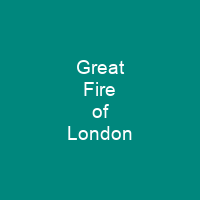The Great Fire of London was a major conflagration that swept through the central parts of London from Sunday, 2 September to Thursday, 6 September 1666. The fire gutted the medieval City of London inside the old Roman city wall. It threatened but did not reach the City of Westminster, Charles II’s Palace of Whitehall, or most of the suburban slums. It is estimated to have destroyed the homes of 70,000 of the City’s 80,000 inhabitants.
About Great Fire of London in brief

By the late 17th century, the City proper—the area bounded by the City wall and the River Thames—was only a part of London, covering some 700 acres, and home to about 80,00 people, or one sixth of London’s inhabitants. It was then, as now, the commercial heart of the capital, and was the biggest city in the world. The Tower of London garrison used gunpowder to create effective firebreaks, halting further spread eastward. A melted piece of pottery on display at the Museum of London found by archaeologists in Pudding Lane, where the fire started, shows that the temperature reached 1,250 °C. Some historians have challenged this belief claiming the deaths of poorer citizens were not recorded and that the heat of the fire may have cremated many victims, leaving no recognisable remains. The City had become progressively more crowded inside its defensive city wall and had also pushed outwards into squalid extramural slums such as Shoreditch, Holborn, and Southwark, and had reached far enough to include the independent City of. Westminster. The battle to put out the fire is considered to have be won by two key factors: the strong east wind dropped, and the Tower of. London garrison use gunpowder, which stopped the spread of the blaze. It is believed that the fire was started in a bakery shortly after midnight on 2 September, and spread rapidly. The use of the major firefighting technique of the time, the creation of firebreaks by means of demolition, was critically delayed due to the indecisiveness of the Lord Mayor.
You want to know more about Great Fire of London?
This page is based on the article Great Fire of London published in Wikipedia (as of Dec. 03, 2020) and was automatically summarized using artificial intelligence.







